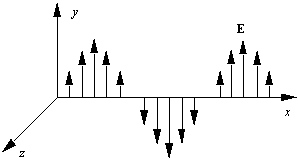| 85. |
The electric field E of an electromagnetic wave traveling the positive x direction is illustrated in the figure. This is the wave of the radiation field of an antenna. What is the direction and the phase relative to the electric field of the magnetic field at a point where the electric field is in the negative y direction?

Note: The wave is shown in a region of space that is a large distance from its source.
|